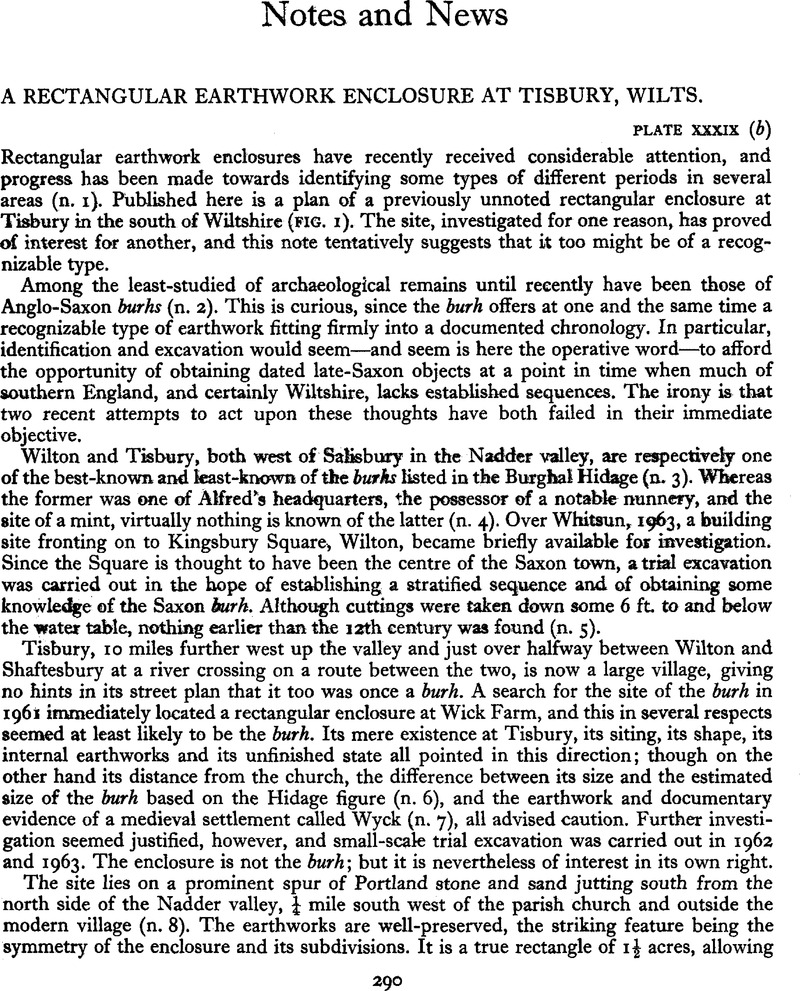No CrossRef data available.
Article contents
A Rectangular Earthwork Enclosure at Tisbury, Wilts
Published online by Cambridge University Press: 02 January 2015
Abstract

- Type
- Notes and News
- Information
- Copyright
- Copyright © Antiquity Publications Ltd 1963
References
(1) Salway, P., Procs. Durham Univ. Phil. Soc. I, ser. B, no. 5 (1959), 42-8Google Scholar; Royal Commission on Historical Monuments (England), A Matter of Time (1960); Jobey, G., Arch. Ael., xxxviii, 4th ser. (1960), 1–38 andxxxrx (1961), 87-102Google Scholar; Cotton, M. A., Berks. Arch. J., 59 (1961), 1–35 Google Scholar; Decker, and Scollar, , Antiquity (1962), 175-8CrossRefGoogle Scholar.
(2) See now Hoskins, W.G., Devon (1954), 427-8, for LydfordGoogle Scholar; Wainwright, F.T., W.A.M., LVI (1955), 162-6Google Scholar, Thomson, T.R., Materials for a History of Cricklade (1958-1961), 63–80 Google Scholar, Loyn, H., W.A.M., LVIII (1961), 7–15, Google Scholar all for Cricklade; Beresford and Joseph, St, Medieval England (1958), 179-81Google Scholar for Wallingford; and R.C.H.M., , Med. Arch., in (1959), 120-38Google Scholar for Wareham; and more generally, Blair, P. Hunter, An Introduction to Anglo-Saxon England (1956), 293 Google Scholar, and Loyn, H., Anglo-Saxon England and the Norman Conquest (1962), 132-6Google Scholar, following the lead of Robertson, A.J., Anglo-Saxon Charters (1956, 2nd ed.), 246-8, 494-5Google Scholar.
(3) Robertson, op. cit., 246-8.
(4) Wilton has now been admirably treated in V.C.H. Wilts., VI (1962), 1 ff.Google Scholar; Tisbury still awaits its historian, though referred to usefully in V.C.H. Wilts., II (1955)Google Scholar.
(5) The excavation was carried out by members of the Salisbury Museum Research Committee, under J. W. G. Musty, to whom I am grateful for permission to use this information and for help in excavating at Tisbury a few weeks earlier.
(6) 500 hides, giving a theoretical circumference of 687 yds. The circumference of the enclosure is about 350 yds.
(7) Everard, and Hoare, , Modern Wilts., The Hundred of Dunworth (1829), 134 Google Scholar; P.N. Wilts. (1939), 196.
(8) NGR: ST/94152861; R.A.F. vertical air photographs CPE/UK 1811, 1112-3. I am grateful to my wife and Miss E. Dowman for help with the survey, and to Mr and Mrs Cary of Wick Farm for their kindness and co-operation.
(9) As shown on Andrews’, and Dury's, Map of Wiltshire (1773), published by the Wilts. Arch. Soc. Records Branch, vol. VII (1952)Google Scholar.
(10) E.g. Allcroft, H., Earthwork of England (1908), 379–614 Google Scholar; the Curwens, in Sussex, Arch. Colls., LXLV (1923), 1–65 Google Scholar; Crawford, and Keiller, , Wessex from the Air (1928), 234, 238 and 242 Google Scholar.
(11) NGR: SU/134733. V.C.H.|Wilts, 1, i (1957), 268, no. 185Google Scholar; W.A.M., XXXVIII (1913), 309 Google Scholar. About 2½ acres.
(12) Respectively at NGR: SY/679935 and SY/802962. Both are likely to be medieval, but are situated on ground sloping down to a stream. Both have been investigated by R.C.H.M. (Eng.), and will appear in a forthcoming Dorset volume.
(13) V.C.H. Wilts., 1, i (1957), 261-79Google Scholar.
(14) Jobey (1961), n. I.
(15) Boon, G.C., T.B.G.A.S., LXXII (1953). 45–8Google Scholar.
(16) Emery, F.V., Geography, XLVII (1962), 378-88Google Scholar.
(17) Piggott, S., P.P.S., II (1936), 229-30. About ½ acreGoogle Scholar.
(18) Cunnington, M., W.A.M., xxxvi (1910), 590-8Google Scholar; V.C.H. Wilts., 1, i (1957). 262, no. 42. About 9 acresGoogle Scholar. Piggott, S., P.P.S., II (1936), 229-30. About ½ acreGoogle Scholar.
(19) To paraphrase Wood, E.S., Field Guide to Archaeology in Britain (1963), 95, no. 93Google Scholar.


